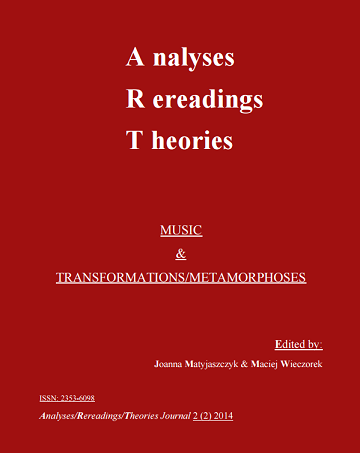Approaching Transhumanism: On How Human Beings Transform in the 21st Century
DOI:
https://doi.org/10.18778/2353-6098.2.11Keywords:
transhumanism, posthumanism, Stelarc, transformation, Neil HarbissonAbstract
The following article is to introduce the reader into a cultural and intellectual movement whose aim is to identify the need for improvement in human life in the sphere of physicality as well as mentality with the aid of modern technologies – transhumanism. With the dramatic change in the perception of technology, transhumanist welcome the opportunity to improve cognitive skills, help to perpetuate human happiness, or increase longevity. Although the opponents of the transhumanist thought dismiss it as “the world’s most dangerous idea,” the adversaries advocate that the alternation of human form is both practical and reasonable. With the use of modern technology, enthusiasts of transhumanism try to prove that the human body needs to be re-invented in order to transcend the natural limitations. In my work I will try to tackle the problem of human body being currently subject to gradual transition from Homo Sapiens to Robo Sapiens, the process of ‘becoming’ a cyborg. By incorporating bodily augmentation, contemporary artists such as Stelarc or Neil Harbisson cast a light on the change of physical form, as well as the definition of being human. Evoking much controversy, transhumanism brings a completely new dimension to the understanding of the current human condition.
References
Bostrom, Nick. “Transhumanist Values.” Nickboctrom.com, n.p. n.d. Web. 10 Apr. 2014.
Google Scholar
Clark, Andy. Natural Born Cyborgs: Minds, Technologies, and the Future of Human Intelligence. Oxford: Oxford UP. 2003. Print.
Google Scholar
Devlin, Matthew. Cultivating Better Brains: Transhumanism and its Critics on the Ethics of Enhancement Via Braincomputer Interfacing. Diss. University of Western Ontario, 2014. Web. 1 Dec 2014.
Google Scholar
“Ear on Arm.” Stelarc.org. Stelarc, n.d. Web. 2 July 2014.
Google Scholar
Fisher, Michael M. J. “Body Marks (Bestial/Natural/Divine): An Essay on the Social and Biotechnological Imaginaries 1920–2008, and Bodies to Come.” Anthropological Features. Durham: Duke UP, 2009. 159-96. Print.
Google Scholar
DOI: https://doi.org/10.2307/j.ctv11hpnzs.7
Fukuyama, Francis. “Transhumanism: The World’s Most Dangerous Idea.” Foreign Policy 144 (2004): 42-43. Print.
Google Scholar
DOI: https://doi.org/10.2307/4152980
Grosz, Elizabeth. “Naked.” The Prosthetic Impulse: From a Posthuman Present to a Biocultural Future. Eds. Marquard Smith and Joanne Morra. Cambridge: MIT Press, 2006. 187-202. Google Books. Web. 2 Dec 2014.
Google Scholar
Haraway, Donna. “A Cyborg Manifesto: Science, Technology, and Socialist-Feminism in the Late Twentieth Century.” The Cybercultures Reader. Eds. David Bell, and Barbara M. Kennedy. London: Routledge, 1991. 291-324. Print.
Google Scholar
Harbisson, Neil. “Cyborg Neil Harbisson Uses His Eyeborg to Listen to Colour.” Dezeen.com. 20 Nov. 2013. Web. 15 June 2014.
Google Scholar
Harbisson, Neil. “I Listen to Color.” TED Global Scotland. June 2012. Web. 10 June 2014.
Google Scholar
Jones, Meredith, and Zoё Sofia. “Stelarc and Orlan in the Middle Ages.” The Cyborg Experiments: The Extensions of the Body in the Media Age. Ed. Joanna Zylinska. London: Continuum, 2002. 139-140. Google Books. Web. 11 Dec 2014.
Google Scholar
Kreps, Andy. Cyborgism: Cyborgs, Performance and Society. Lulu.com. 2007. Google Books. Web 15 June 2014.
Google Scholar
Massumi, Brian. “The Evolutionary Alchemy of Reason – Stelarc.” Parables for the Virtual: Movement, Affect, Sensation. Durham: Duke UP, 2002. 89-132. Google Books. Web. 6 Dec 2014.
Google Scholar
DOI: https://doi.org/10.1215/9780822383574-005
More, Max. “On Becoming Transhuman.” maxmore.com. Max More, 1994. Web. 2 July 2014.
Google Scholar
Stelarc. “Extended-Body: Interview with Stelarc.” Ctheory.net. n.p., n.d. Web. 7 July 2014.
Google Scholar
“Stelarc Early Texts.” Stelarc.org. Stelarc, n.d. Web. 2 July 2014.
Google Scholar
Tirosh-Samuelson, Hava. “Engaging Transhumanism.” H± Transhumanism and its Critics. Ed. Gregory R. Hansell and William Grassie. Philadelphia: Metanexux Institute, 2011. 19-54. Print.
Google Scholar
Van Zyl, Susanne Hildegard. “Crossing the Boundaries: Stelarc’s Artworks and the Reclaiming of the Obsolete Body.” Diss. University of the Witwatersrand, 2008. Web. 2 July 2014.
Google Scholar
Vita-More, Natasha. “Bringing Arts/Design into the Discussion of Transhumanism.” H± Transhumanism and Its Critics. Ed. Gregory R. Hansell and William Grassie. Philadelphia: Metanexus Institute, 2011. 70-83. Print.
Google Scholar
Zylinska, Joanna, and Gary Hall. “Probings: an Interview with Stelarc (with G. Hall).” The Cyborg Experiments: The Extensions of the Body in the Media Age. Ed. Joanna Zylinska. London: Continuum, 2002. 114-130. Google Books. Web. 11 Dec 2014.
Google Scholar
Downloads
Published
How to Cite
Issue
Section
License

This work is licensed under a Creative Commons Attribution-NonCommercial-NoDerivatives 3.0 Unported License.









